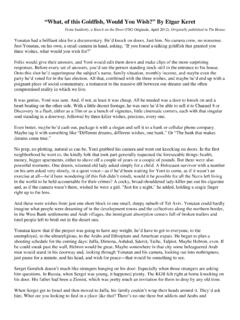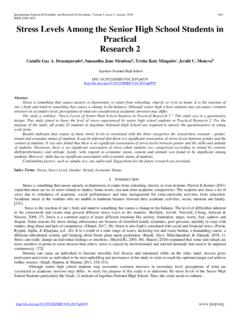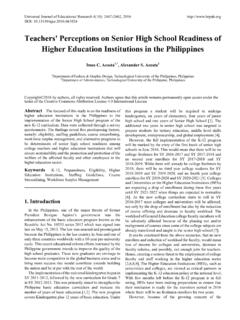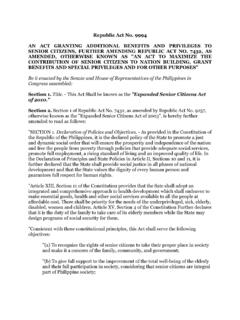Transcription of H-W Answer Key 10 - Hialeah Senior High School
1 Answer Key AP Biology Name: December 12, 2007 How to Solve Hardy-Weinberg Problems 1. Figure out what info you re given. Is it allele frequency, genotype frequency, p, q, 2pq, p2, q2? 2. Determine exactly what the question is asking for. 3. Use the p + q=1 or p2 + 2pq + q2 = 1 formulas to plug in known values to solve for unknowns. 4. Answer the question! Seriously. This seems obvious, but don t spend your time solving and writing info for answers you don t need. 5. You should be able to do ALL of these problems without a calculator. You don t get a calculator on the AP exam. Also, most of these H-W problems will be multiple choice and you have an average of 48 seconds per multiple choice question. 6. To save yourself time, learn to recognize your square roots to figure out allele frequencies.
2 You read, A certain recessive trait occurs in 64% of the , you should automatically be thinking q= .64= Practice problem from Tuesday: Assume a population is in Hardy-Weinberg equilibrium for a given genetic autosomal trait. What proportion of individuals in the population are heterozygous for the gene if the frequency of the recessive allele is 1%? What info are you given? Recessive allele = q = What is the question asking? Proportion of heterozygous = 2pq. What do you need to solve for in order to Answer the question? If q = , then p = Answer : 2pq = NOW YOU TRY: You have sampled a population in which you know that the percentage of the homozygous recessive genotype (aa) is 36%. Using that 36%, calculate the following: a) The frequency of the "aa" genotype. Homozygous recessive genotype = b) The frequency of the "a" allele. q = = c) The frequency of the "A" allele. 1 q = p = d) The frequencies of the genotypes "AA" and "Aa.
3 " p2 = 2pq = e) The frequencies of the two possible phenotypes if "A" is completely dominant over "a." Dominant = p2 + 2pq = + = Recessive = Problem Set (Note: You will need your calculator for some of these problems) 1. Some people taste the chemical phenylthiocarbamide (PTC) as intensely bitter, while others cannot taste it at all. PTC is similar to chemicals in broccoli, brussel sprouts, and cabbage, among other plants. Tasting PTC is a dominant trait; non-tasting is recessive. About 50% of people of European descent are tasters. If all of the assumptions of Hardy-Weinberg equilibrium are met, then among people of European a) What is the frequency of the non-taster phenotype? Explain. If 50% are tasters, 50% are non-tasters. b) What is the frequency of the homozygous recessive genotype? Explain. Homozygous recessive genotype = 50% (all non-tasters) c) What is the frequency of the non-taster allele?
4 Show how you determined this. Homozygous recessive = q2 = Non-taster allele = q = = d) What is the frequency of the taster allele? Show how you determined this. 1-q = p. p = .29 e) What is the frequency of each of the three genotypes? Show how you determined each one. p2 = .084 (homozygous dominant). 2pq = (heterozygous). q2 = .5 (homozygous recessive) 2. If the frequency of the dominant allele F for free-hanging earlobes is 60%, a) What is the frequency of the only other allele at this locus (f, which is a recessive allele for attached earlobes)? Explain. (info given is allele ) p= 1-p = q = f = b) If all of the assumptions of Hardy-Weinberg equilibrium are met, what is the frequency of each of the three genotypes? Show how you determined each frequency. FF = p2 = .36 Ff = 2pq = .48 ff = q2 = .16 c) What fraction of the population has free-hanging earlobes? Show how you determined this.
5 Free-hanging earlobes = dominant phenotype Represented by 2pq + p2 = .48 + .36 = .84 3. Let s say we do a study of 10,000 North Americans. At the beginning of the study, the frequency of the dominant tongue roller allele is 45%. p= Therefore q = for original generation a) After 5 generations, we find that 75% can roll their tongues. Is this population in Hardy-Weinberg equilibrium. Justify your Answer and show the appropriate calculations below. If population is in Hardy-Weinberg equilibrium, the number of tongue rollers should stay the same from first generation to fifth. If it has changed, then population is not in equilibrium. First generation tongue-rollers = p2 + 2pq = 2( )( ) + = Not in Hardy-Weinberg equilibrium b) Suggest a reason or scenario that might explain the situation in this question. Be creative, but try to convince me that your scenario makes sense from a genetic and evolutionary point of view.
6 Any explanation that would decrease the frequency of q is acceptable. Show example of 5 point of Hardy-weinberg not fitting. 4. There are 100 students in a class. Ninety-six did well in the course whereas four blew it totally and received a grade of F. Sorry. In the highly unlikely event that these traits are genetic rather than environmental, if these traits involve dominant and recessive alleles, and if the four (4%) represent the frequency of the homozygous recessive condition, please calculate the following: a) The frequency of the recessive allele. = q2 q = b) The frequency of the dominant allele. p + q = 1. p = c) The frequency of heterozygous individuals. Heterozygote represented by 2pq = 5. Within a population of butterflies, the color brown (B) is dominant over the color white (b). And, 49% of all butterflies are white. Given this simple information, which is something that is very likely to be on an exam, calculate the following: a) The percentage of butterflies in the population that are heterozygous.
7 White = = q2 q = 1-q=p. p = 2pq = 2 ( )( ) = or 42% are heterozygous b) The frequency of homozygous dominant individuals. p2 = = = homozygous dominant 6. A very large population of randomly-mating laboratory mice contains 35% white mice. White coloring is caused by the double recessive genotype, "aa". Calculate allelic and genotypic frequencies for this population. = white = aa = q2 p2 = homozygous dominant = .17 q = = 2pq = heterozygous = 2( )( ) = .48 p + q = 1 p = q2 = homozygous recessive = 7. In a given population, only the "A" and "B" alleles are present in the ABO system; there are no individuals with type "O" blood or with O alleles in this particular population. If 200 people have type A blood, 75 have type AB blood, and 25 have type B blood, what are the allelic frequencies of this population ( , what are p and q)? NOT using Hardy-Weinberg. Must count up all the alleles in the population and calculate the proportion of each.
8 (200 x 2) + 75 = 475 = A (25 x 2) + 75 = 125 = B Total number of alleles in gene pool = 600 A allele frequency = p = 475/600 = .79 B allele frequency = q = 125/600 = .21 8. What assumptions are necessary for Hardy-Weinberg equilibrium? - no mutation, no migration, large population, no selection, random mating Part II: Sexual Selection (NOTE: These are only simple suggested may have a slightly different Answer or more complex explanation and that s fine) 9. Revise these statements to follow a Darwinian explanation a) The children of body builders tend to be much more athletic, on average, than other children because the characteristics and abilities gained by their parents have been passed on to the children. The parents cannot pass on traits they acquired during their lifetimes. They can pass on only the genes that they have. The children of body builders tend to be more athletic, on average, than other children.
9 Body builders may tend to have specific genes for these traits, or they may train their children to become athletic more than other people do. b) Life arose in the aquatic environment and later invaded land. Once animals came onto land, they had to evolve effective methods of support against gravity and locomotion in order to survive. If the animals were not already able to support themselves and move in gravity, they would not have survived on land. Life arose in the aquatic environment and later invaded land. The animals that came onto land had to have previously evolved effective methods of support against gravity and locomotion in order to survive. 10. What is sexual selection? How is it different than natural selection? Natural selection could be fitness for any trait (tongue-rolling or sickle-cell) Sexual selection refers specifically to fitness for mating (peacock feathers and sexual dimorphisms) 11.
10 Two different bird species (species A and B) live in the same environment. In species A, there is significant sexual dimorphism between males and females. Males are slightly larger, brightly colored and sing a complex song. Females are smaller and brown colored. In species B, there is very little sexual dimorphism. Both males and females are essentially the same size and both are brown colored. a) How would Darwin explain how the males in species A came to be larger and brightly colored. Possible Answer : Males that had genes that gave them more brightly colored feathers were preferred by the females in species A. These genes for bright feathers were passed down to subsequent generations. Eventually males who were bigger and brighter were more prevalent in the population since the smaller, duller males were sexually selected against by the females. b) Propose an explanation for why the level of sexual dimorphism seen in both bird species is so markedly different.






